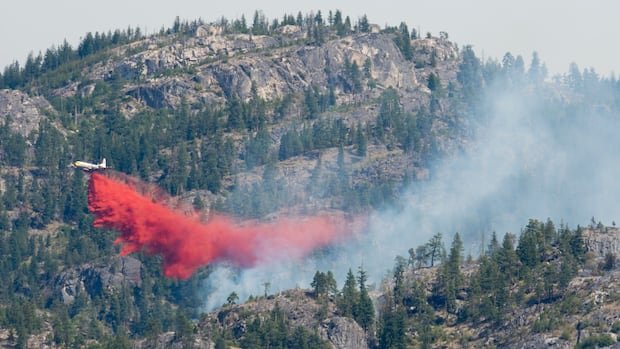Dropping fire retardant solutions from aircraft plays a vital role in combatting wildfires, although concerns exist regarding their environmental impact, particularly on aquatic ecosystems.
After deployment, these retardants create a reddish or pinkish liquid layer on surfaces like roads, rooftops, and plants. This method, utilized since the mid-20th century, aids firefighting efforts by cutting off oxygen supply to flames, as explained by Jen Baron, a postdoctoral researcher at the University of British Columbia’s Center for Wildfire Coexistence.
Since 2009, the B.C. Wildfire Service has been utilizing Phos-Chek LC-95A, a popular retardant produced by Perimeter Solutions, a global firefighting products manufacturer based in the U.S. Its primary component, ammonium polyphosphate, is a common fertilizer.
Additional substances, such as iron oxide, give the retardant its distinctive red hue, assisting crews in identifying treated areas. The precise chemical composition of the retardant, however, remains undisclosed.
While there is limited research on the environmental effects of retardants, they are generally presumed to be safe for both people and the environment, according to Baron. Nevertheless, precautions are taken to avoid their release near water bodies due to potential risks posed by ammonia and phosphate to aquatic life.
In a study conducted by Uldis Silins, a forest hydrology professor at the University of Alberta, it was revealed that accidental discharge of Phos-Chek LC-95A into North Racehorse Creek in Alberta led to phosphorus-enriched sediments being found downstream a year later. This challenges the belief that retardants swiftly dissipate from ecosystems post-application.
As wildfires intensify with climate change, the use of retardants is anticipated to rise, with Silins cautioning that accidents are inevitable. While acknowledging the value of retardants in safeguarding lives and properties during wildfires, the need for further research on their composition and environmental impacts is emphasized.
Efforts are underway to explore alternative retardant options, like those incorporating cellulose fiber, which could offer eco-friendly alternatives with reduced ecological impacts. Perimeter Solutions, the company behind Phos-Chek, asserts that their product undergoes rigorous testing and must be applied following established guidelines to prevent adverse effects on the environment.

